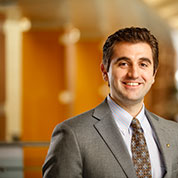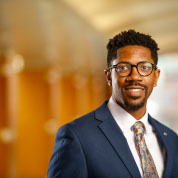Research
Because we recognize the educational value provided by focused research training, the Neurological Surgery Residency Program designates and funds a 12 month research experience. During this period, the resident is designated as a Research Fellow in Neurological Surgery and works in a research laboratory with a departmental research faculty member or a faculty member from a related URMC research area.
The department has close associations with our colleagues in the Department of Neurology, and in the Divisions of Neuropathology and Neuroradiology as well as the Clinical Translational Science Institute. The department with the approval of the ACGME has a 6 month International Research Skull Base rotation in Australia for those residents interested in applying. In addition, the department has close interactions with affiliated laboratories and research centers in both the medical center and adjacent university campus that include:
Resident Research Focus
Redi Rahmani, M.D.

Redi Rahmani, M.D. (PGY-7), arrived at UR Medicine in 2016 for his neurosurgery residency, joining the medical center from the Geisel School of Medicine at Dartmouth College.
He earned his Bachelor of Science degree at Cornell University, where he began to pursue his interest in research by working in the Deitcher Genetics Laboratory to locate and characterize the M52 mutation in Drosophila melanogaster through genetic recombination, sequencing, antibody staining and heat shocking. At Dartmouth, he conducted a prospective study of post-operative falls in the elderly undergoing neurosurgical procedures and their discharge level of care. This was one of several topics he undertook while working with research partner Kimon Bekelis, MD.
At URMC, Dr. Rahmani is the principal investigator of a multicenter, nationally registered clinical trial comparing lumbar drainage to external ventricular drainage in aneurysmal subarachnoid hemorrhage for the prevention of delayed cerebral ischemia. He is initiating a trial on thromboelastography in aneurysmal subarachnoid hemorrhage for the detection of delayed cerebral ischemia. He is also the resident director of the neurosurgery anatomy laboratory and has taken lead in its redesign. This will be a nearly million-dollar project to develop a cutting edge cranial and spinal surgical training lab for daily resident use and regional courses. Now in his fourth year of residency, Dr. Rahmani has been published in a variety of medical journals including Journal of Neurosurgery, Neurosurgery, World Neurosurgery, Journal of Neurosurgery: Pediatrics, PLoS ONE, Spine Journal, and Neuromodulation. He has given presentations at a number of conferences and was elected to be a fellow of the Council of State Neurosurgical Societies. He will be spending his research year at The Barrow Neurological Institute studying the pathophysiology of intracranial aneurysm development. He is interested in vascular and skull base surgery.
David Paul, M.D., M.S.

David Paul, MD, MS, (PGY-7) is a native of Grand Rapids, Michigan, was first introduced to medicine as a young child while accompanying his grandfather on pastoral rounds at a small rural community hospital. The impact that doctors hand on these patients left its impression on David and he decided to pursue a career in Medicine. As an undergraduate, David attended Hope College in Holland, MI, where he developed an interest in research, was elected Student Body President, and now serves as a member of their Board of Trustees. He chose Hope for it’s track record of producing top applicants for medical school. He was then attracted to the University of Rochester for Medical school, stating in Rochester Review Magazine that he “felt like everyone in the school was genuine,” and that “No one was haughty or prideful here.”
Learning of Paul’s interest in research, Dr. G. Edward Vates quickly became his mentor. David had the opportunity to develop his interest in academic neurosurgery with Dr. Vates’ guidance, completing a pilot study of a new way to measure myelin changes within the brain’s visual system. The study was published in Science magazine in 2014 while David was a medical student. It was only natural that he should be matched with the department for his residency—good news for his family, as his wife graduated from the Simon School of Business at the University of Rochester in 2016 and started a career at the Wegmans corporate offices. Together, they have an eighteen-month old son, who they adore. Outside of the operating room and laboratory, David and his wife enjoy mentoring youth in Rochester, spending time with their son, exploring the outdoors, and cooking.